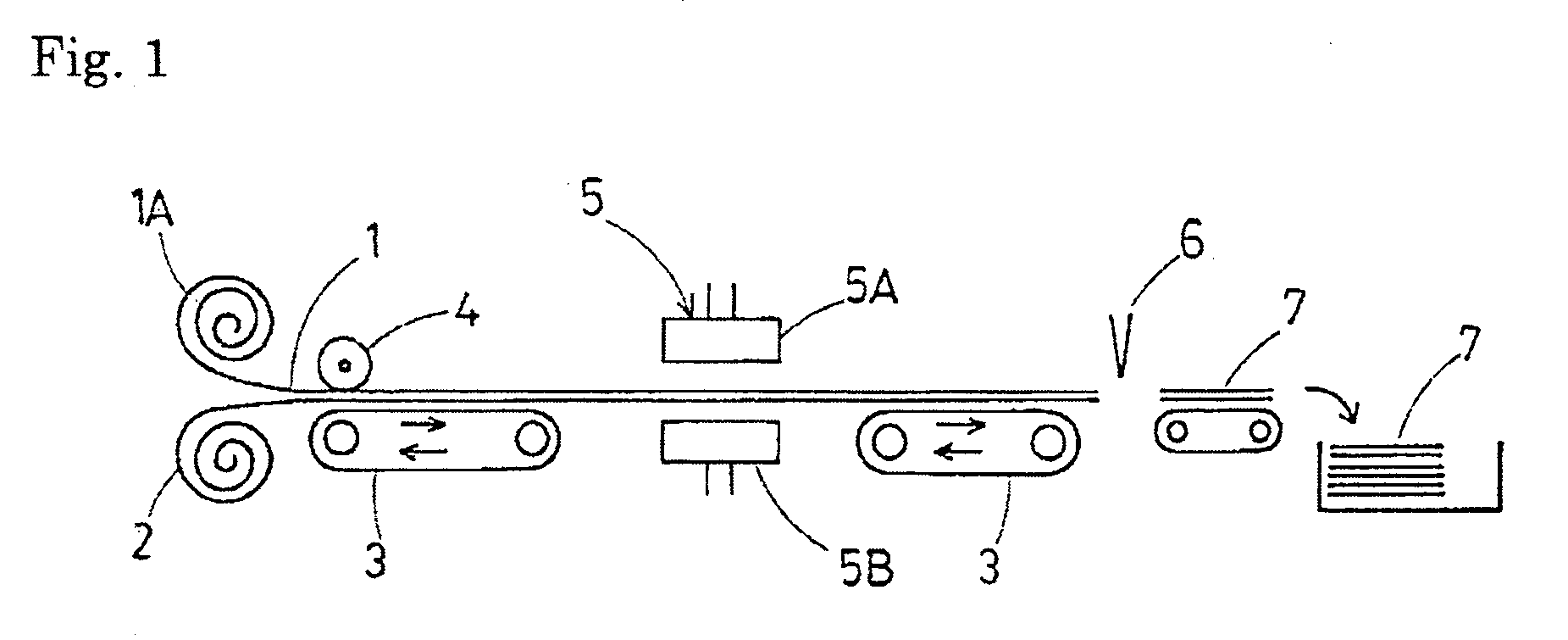Formable Sheet and Interior Finishing Material
a technology of moldable sheets and interior finishing materials, applied in the field of moldable sheets, can solve problems such as degrading moldability, and achieve the effects of adequate elongation, low toxicity, and adequate elongation
- Summary
- Abstract
- Description
- Claims
- Application Information
AI Technical Summary
Benefits of technology
Problems solved by technology
Method used
Image
Examples
example 1
[0105]Diethylene glycol (DGE) was added to a phenol-formaldehyde precondensate (50% by mass aqueous solution) in amounts of 0.1, 5.0, 10.0, 20.0, 40.0, 50.0% by mass respectively for the solid in the solution, to prepare mixed solutions. Said mixed solutions were each then coated on and impregnated into fiber sheets, being needle punched nonwoven fabrics made of polyester fiber having a unit weight of 150 g / m2, in a coating amount to be 45 g / m2, 30% by mass as a solid by using a roll coater, after which said nonwoven fabrics were each dried at 120 to 130° C. for two minutes, to put said precondensate in each nonwoven fabric at its B-stage, to prepare the moldable sheet samples A.
example 2
[0106]Polyethyleneglycol (PEG) was added to an acrylic resin emulsion (50% by mass solid content) in amounts of 0.1, 5.0, 10.0, 20.0, 40.0, 50.0% by mass for solid of said acrylic emulsion to prepare mixed solutions.
[0107]Glass fiber sheets having a unit weight of 100 g / m2 were put on fiber sheets, being polyester fiber spun bonded nonwoven fabric having a unit weight of 30 g / m2, and said mixed solutions were each spraycoated onto said glass fiber sheets in a coating amount to be 60 g / m2, 60% by mass as a solid, after which said two layer sheets were each dried at 120 to 130° C. for two minutes, to prepare moldable sheet samples B onto which said polyester nonwoven fabrics were respectively laminated.
[0108][Comparison 1]
[0109]Moldable sheet samples C were prepared in the same manner as in EXAMPLE 1 with the exception that diethylene glycol was added separately to said phenol-formaldehyde precondensate aqueous solutions in an amount of 0.05, 60.0% by mass.
[0110][Comparison 2]
[0111]Mo...
example 3
[0145]A mixed solution was prepared by mixing 30 parts by mass of a sulfomethylated phenol-alkylresorcin-formaldehyde precondensate (solid content: 50% by mass, aqueous solution), 5 parts by mass of ethyleneglycol, 1 part by mass of a carbon black dispersion (solid content:35% by mass aqueous dispersion), 2 parts by mass of water and an oil repellent containing fluorine (solid content 20% by mass aqueous solution), 2 parts by mass of a fire retardant (containing nitrogen and phosphorous solid content 50% by mass aqueous solution) and 60 parts by mass of water.
[0146]Said mixed solution was then coated on and impregnated in to a fiber sheet, being a spunbonded nonwoven fabric made of polyester fibers having a unit weight of 30 g / m2, by the roll in a coating amount to be 45% by mass, after which said fiber sheet was then dried at 120 to 130° C. for one minute to put said precondensate in said fiber sheet at its B-stage, to obtain a moldable sheet. The resulting moldable sheet was then ...
PUM
| Property | Measurement | Unit |
|---|---|---|
| melting point | aaaaa | aaaaa |
| temperature | aaaaa | aaaaa |
| RH | aaaaa | aaaaa |
Abstract
Description
Claims
Application Information
 Login to View More
Login to View More - R&D
- Intellectual Property
- Life Sciences
- Materials
- Tech Scout
- Unparalleled Data Quality
- Higher Quality Content
- 60% Fewer Hallucinations
Browse by: Latest US Patents, China's latest patents, Technical Efficacy Thesaurus, Application Domain, Technology Topic, Popular Technical Reports.
© 2025 PatSnap. All rights reserved.Legal|Privacy policy|Modern Slavery Act Transparency Statement|Sitemap|About US| Contact US: help@patsnap.com


